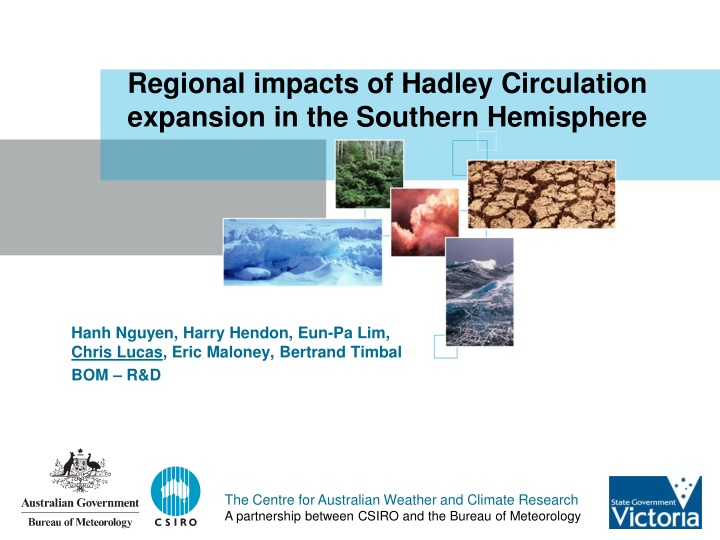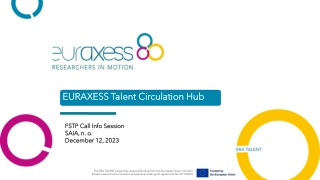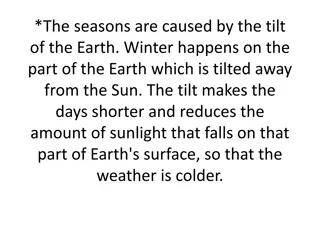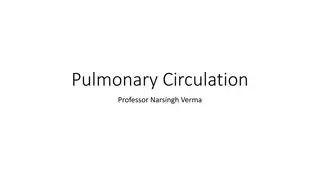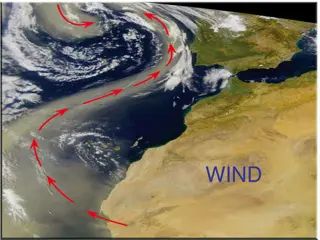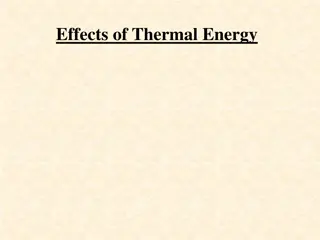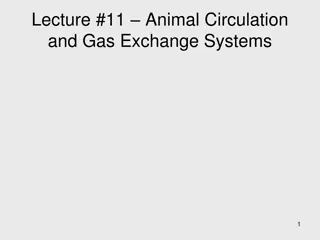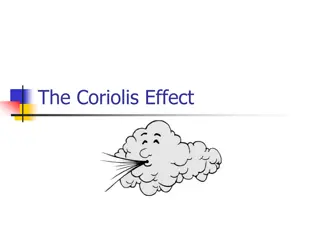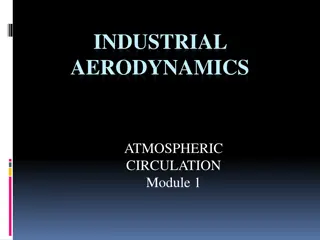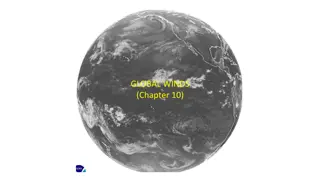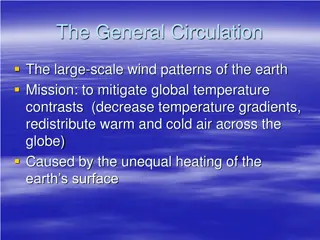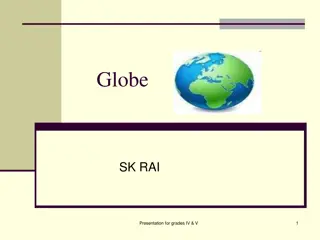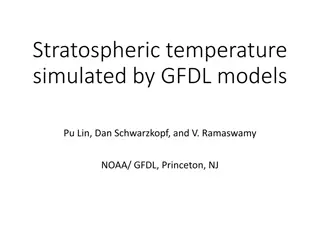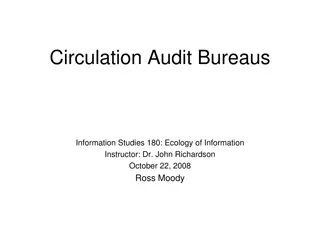Impacts of Hadley Circulation Expansion in Southern Hemisphere
Regional impacts of Hadley Circulation expansion in the Southern Hemisphere studied by Hanh Nguyen, Harry Hendon, Eun-Pa Lim, Chris Lucas, Eric Maloney, and Bertrand Timbal. Research explores quantifying regional contribution, identifying impacts, and understanding mechanisms behind the expansion. The study, conducted in partnership between CSIRO and the Bureau of Meteorology, investigates the expansion's effects on climate variability and regional Hadley Circulations.
Download Presentation

Please find below an Image/Link to download the presentation.
The content on the website is provided AS IS for your information and personal use only. It may not be sold, licensed, or shared on other websites without obtaining consent from the author.If you encounter any issues during the download, it is possible that the publisher has removed the file from their server.
You are allowed to download the files provided on this website for personal or commercial use, subject to the condition that they are used lawfully. All files are the property of their respective owners.
The content on the website is provided AS IS for your information and personal use only. It may not be sold, licensed, or shared on other websites without obtaining consent from the author.
E N D
Presentation Transcript
Regional impacts of Hadley Circulation expansion in the Southern Hemisphere Hanh Nguyen, Harry Hendon, Eun-Pa Lim, Chris Lucas, Eric Maloney, Bertrand Timbal BOM R&D The Centre for Australian Weather and Climate Research A partnership between CSIRO and the Bureau of Meteorology
Regional Tropical Expansion and Climate Variability 0.5 - 0.8 0.2 - 0.3 0.1 - 0.5 0.4 0.5 0.3 - 0.8 0.2 - 0.3 2
Motivations How to quantify regional contribution to the zonal mean Hadley circulation expansion? Identify regional impacts of Hadley Circulation expansion. Mechanism behind Hadley Circulation expansion? The Centre for Australian Weather and Climate Research A partnership between CSIRO and the Bureau of Meteorology
Three centers of action Europe-Africa (EA = 25oW-60oE) Asia-Pacific (AP = 60oE-175oW) Americas (AA = 175oW-25oW) Shading: divergence Contours: velocity potential Vectors: divergent winds The Centre for Australian Weather and Climate Research A partnership between CSIRO and the Bureau of Meteorology
Regional Hadley Circulations (annual mean) Americas Eurpe-Africa Asia-Pacific Marked regional variability in the Hadley Circulation: strongest and widest over Asia-Pacific. The Centre for Australian Weather and Climate Research A partnership between CSIRO and the Bureau of Meteorology
Definition of the HC edges HC edge defined as the poleward location of the near-zero value of the overturning streamfunction (=25% of the peak value) averaged between 700-400 hPa. The Centre for Australian Weather and Climate Research A partnership between CSIRO and the Bureau of Meteorology
Annual mean time series of the HC edges Southern Hemisphere Europe-Africa Asia-Pacific Americas mean anomalies The longitudinally weighted average of three regional edges loosely follows the hemispheric edge. Marked regional variability of the HC edge. Variability in the Asia-Pacific resembles the most to the hemispheric HC edge. The Centre for Australian Weather and Climate Research A partnership between CSIRO and the Bureau of Meteorology
Seasonal mean evolution of the HC edge for the Asia-Pacific sector Annual DJF MAM JJA SON Season ANN DJF MAM JJA SON Trend 0.71*** 0.67* 0.71** 0.53** 0.69 The Centre for Australian Weather and Climate Research A partnership between CSIRO and the Bureau of Meteorology
Circulation anomalies regressed onto annual mean HC edge upper level (200hPa) Shading: SST contours: geopotentical height vectors: winds lower level (850hPa) Shading: precipitation contours: MSLP vectors: winds Southern hemisphere Asia-Pacific The Centre for Australian Weather and Climate Research A partnership between CSIRO and the Bureau of Meteorology
Circulation anomalies regressed onto Asia- Pacific annual mean HC edge upper level (200hPa) Shading: SST contours: geopotentical height vectors: winds lower level (850hPa) Shading: precipitation contours: MSLP vectors: winds The Centre for Australian Weather and Climate Research A partnership between CSIRO and the Bureau of Meteorology
Conclusion Local Hadley circulation defined using divergent winds. The southern hemisphere HC is dominated by the behavior of the HC in the Asia-Pacific sector: most of HC expansion over the hemisphere occurs in the Asia-Pacific (where the tropical convective heat source is largest). SST La Ni a conditions to drive the HC expansion which may explain why models have underestimated the expansion in the historical period (ensemble mean models do not depict this La Ni a condition or swing to cold IPO). Next step: separate long term trends and inrerannual variability 11 The Centre for Australian Weather and Climate Research A partnership between CSIRO and the Bureau of Meteorology
Thank you. Chris Lucas C.Lucas@bom.gov.au The Centre for Australian Weather and Climate Research A partnership between CSIRO and the Bureau of Meteorology
